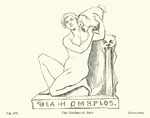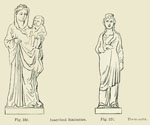Previous First Next
SALAMIS IN THE ISLAND OF CYPRUS.
BY ALEXANDER PALMA DI CESNOLÀ, F.S.A.,
page 96
a loop under her right arm, while part of that garment is wrapped about her left arm, wears a kerchief on her head, in which she has bound the masses of her hair. The costume is finely treated.1 Besides the above-mentioned figures of ladies, there are
1 This illustration also is kindly lent to me by the British Archaeological Association.  two statuettes of women bearing offerings. Each of them carries a dove held before her body in a highly characteristic fashion. These are probably peasant women, who are bearing offerings to the Temple of Venus. The female who carries the bird, with out-spread tail, has hair coloured of a deep red. A statuette of a portly matron seems to convey a touch of satire such as is of no uncommon occurrence in these works. She sits and holds a partly unrolled scroll on her knees, and, altogether, as if she were one of those "thirsty plants imbibing", whom the Laureate satirised in his account of the pupils of the "Princess". Two associated examples, seated side by side, are, unfortunately, broken; but enough exists to shew that one has extended on her knees a half-unrolled scroll, coloured blue, from which, as her action unmistakeably declares, she is in the act of singing. In one hand, she holds a spherical object, probably a ball. The companion member of this group is broken. It is believed to have originally carried a musical instrument. A tall damsel bears offerings of grapes in one hand, and fruit of different kinds, or flowers, in a dish in the other. The collection contains also the representation in terra-cotta of a young woman advancing against the wind, as the positions of her legs and hands and the disposition of her draperies suggest. A torch is in her left hand, the flame of which is drawn backwards. On the head is a wreath; the hair is tied in a long knot. This is two statuettes of women bearing offerings. Each of them carries a dove held before her body in a highly characteristic fashion. These are probably peasant women, who are bearing offerings to the Temple of Venus. The female who carries the bird, with out-spread tail, has hair coloured of a deep red. A statuette of a portly matron seems to convey a touch of satire such as is of no uncommon occurrence in these works. She sits and holds a partly unrolled scroll on her knees, and, altogether, as if she were one of those "thirsty plants imbibing", whom the Laureate satirised in his account of the pupils of the "Princess". Two associated examples, seated side by side, are, unfortunately, broken; but enough exists to shew that one has extended on her knees a half-unrolled scroll, coloured blue, from which, as her action unmistakeably declares, she is in the act of singing. In one hand, she holds a spherical object, probably a ball. The companion member of this group is broken. It is believed to have originally carried a musical instrument. A tall damsel bears offerings of grapes in one hand, and fruit of different kinds, or flowers, in a dish in the other. The collection contains also the representation in terra-cotta of a young woman advancing against the wind, as the positions of her legs and hands and the disposition of her draperies suggest. A torch is in her left hand, the flame of which is drawn backwards. On the head is a wreath; the hair is tied in a long knot. This is  probably a Bacchante, or a Maenad, under the influence of Bacchanalian inspiration. A tall female figure stands by a lofty pedestal, or column, and, holding upwards her coronetted head, rests her right arm on it, while her drapery drops freelyfrom her Angers. A naked femalereclines against a rock, with a vase on her shoulder, and is the nymph of a spring; water pours from a lion's head at her side. The inscription, in Greek capital letters on the base, " ΘΕΑ H OMBPIΟΣ", attests that this is the Goddess or Nymph of Rain (fig. 219). Green colour is still 'distinctly shewn upon the pouring water. A demi-figure, the lower half probably a Bacchante, or a Maenad, under the influence of Bacchanalian inspiration. A tall female figure stands by a lofty pedestal, or column, and, holding upwards her coronetted head, rests her right arm on it, while her drapery drops freelyfrom her Angers. A naked femalereclines against a rock, with a vase on her shoulder, and is the nymph of a spring; water pours from a lion's head at her side. The inscription, in Greek capital letters on the base, " ΘΕΑ H OMBPIΟΣ", attests that this is the Goddess or Nymph of Rain (fig. 219). Green colour is still 'distinctly shewn upon the pouring water. A demi-figure, the lower half  of which is lost, carries an infant rolled in her voluminous toga, exactly in the same manner as that of innumerable groups of the "Virgin and. Child". In another example, a woman carries on her shoulder a draped child, who sits at ease in themost natural manner. A fully-draped lady
(fig. 220), whose tunic is drawn over her head, stands erect, and carries a draped infant upon her left shoulder. On the front of the stand, or plinth, at the foot of this statuette, perhaps Demeter Kourotrophos, which I obtained from excavations at Dali, is the Cypriote inscription:— of which is lost, carries an infant rolled in her voluminous toga, exactly in the same manner as that of innumerable groups of the "Virgin and. Child". In another example, a woman carries on her shoulder a draped child, who sits at ease in themost natural manner. A fully-draped lady
(fig. 220), whose tunic is drawn over her head, stands erect, and carries a draped infant upon her left shoulder. On the front of the stand, or plinth, at the foot of this statuette, perhaps Demeter Kourotrophos, which I obtained from excavations at Dali, is the Cypriote inscription:—

which may be read—Ύιμοκλεφος, perhaps a Cypriote name in the genitive case, to be referred to Timocles, who was in all probability the artist who made the statuette. The standing figure of another lady (fig. 221), whose hand is wrapped in her toga, and on whose head is a coronet, retains a complete coat of brilliant white. The plinth, or black lines, as if it had been intended to cancel the inscription. The Cypriote inscription is as follows:—

Previous First Next
|